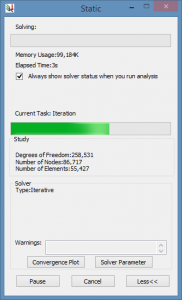I think it’s safe to assume that most FEA users have at some point experienced a sudden urge to violently shake their computer. Fantasies of the gratifying impact between a clenched fist and a (temporarily useless) keyboard would not be uncommon among this group either. The reason behind these manic feelings? A study is taking forever to solve – as in, it’s been solving for 10 minutes now even though you expected it to be done 5 minutes ago.
If you’re nodding your head right now, you’re probably not alone. But I wonder: is this reaction really justifiable? Or have we simply been spoiled by all the instant technological gratification of the internet age? Speaking for myself, if a video on a website is taking longer than approximately 5 seconds to load, I’m probably pondering closing that browser tab with the whoosh of a Ctrl+W keyboard shortcut. By the time the wake of turbulent air over my keyboard settles down, I’ve already moved on.
To gain at least a bit of appreciation for what your computer is doing when you click Run in SOLIDWORKS Simulation, let’s look at a simple structural FEA analysis (a basic Simulation Tutorial actually):

At first glance, this model might seem boring. It’s certainly nothing special – just a plain, unassuming bracket. But consider what actually takes place when we set up a basic study by specifying only the following:

- The material (Alloy Steel from the SOLIDWORKS Material Library, which contains required material properties of the Elastic Modulus and Poisson’s Ratio)
- A Restraint on the two bolt holes
- A pressure on a face
The instant we click the magical ![]() button, something pretty amazing happens.
button, something pretty amazing happens.
First, a mesh is created for us. Essentially, the software automatically takes the CAD geometry and creates a skin of small, interlocking triangles on the outer faces. Then, these two-dimensional surface triangles are transformed to three-dimensional tetrahedron volumetric elements. For this tutorial model, 55,000 such elements were generated and meshing took just a single second.

Our model is now discretized and ready for the next step – processing and compiling all the user input that’s in the study definition into a gargantuan set of equations. This involves the formation of massive matrices (remember those things from school?)
Once that’s done, the solver is unleashed on our matrix. But this isn’t like those relatively innocent looking 3×3 matrices where you’re solving for 3 unknowns using your preferred Gaussian elimination technique. No, we’re talking beastly matrices which often have hundreds of thousands of unknowns being solved. To be exact, 258,531 so-called Degrees of Freedom (DOF) in the case of our example.

How long does it take for the solver to consume and digest this mathematical monstrosity? Four seconds. And now we have the deformed shape of our humble little bracket, with exact XYZ displacement quantities for every single corner (node) of each element.
A few additional operations follow, including stress and resultant force calculations (you know, just in case you’re into that sort of thing). And before you know it, you’re looking at colorful result plots.

All in a matter of about 7 seconds from the instant you clicked Run. So why might some of your studies take much longer to solve? The answer is simple! Complexity. For instance, contact between multiple bodies, a much larger number of elements, or perhaps a transient analysis.
So now that you know how much effort your computer is putting into solving even a very simple analysis like the one mentioned here, imagine just how many difficult equations it’s solving for you in a study that takes more than a few minutes! So relax, and next time you find yourself getting impatient during solving, work on something else (or don’t – I’m not your boss). And give your computer an appreciative pat on the housing to thank it for saving you from calculating all of this out by hand.
Original Post Created by Jay Seaglar, Senior Simulation Guy at DS SOLIDWORKS

SUBMIT YOUR COMMENT